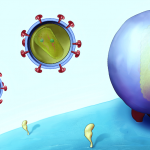 Antiretroviral therapy (ART) affects the way HIV disseminates and establishes infection in the female reproductive tract, which could have significant implications for future HIV prevention, vaccine and cure studies, because vaginal transmission accounts for most HIV infections worldwide, according to investigators in the Division of Infectious Diseases at the University of North Carolina (UNC) at Chapel Hill School of Medicine.
Antiretroviral therapy (ART) affects the way HIV disseminates and establishes infection in the female reproductive tract, which could have significant implications for future HIV prevention, vaccine and cure studies, because vaginal transmission accounts for most HIV infections worldwide, according to investigators in the Division of Infectious Diseases at the University of North Carolina (UNC) at Chapel Hill School of Medicine.
“Surprisingly, it does not matter how a woman is exposed to HIV—vaginally, rectally, etc.—the virus goes very quickly to the female reproductive tract,” said J. Victor Garcia-Martinez, PhD, study co-author and a professor of medicine in the Center for AIDS Research, the Institute for Global Health & Infectious Diseases, and the Division of Infectious Diseases at UNC School of Medicine.
“Your body’s CD4 T cells, which are the cells HIV infects, also migrate to the female reproductive tract shortly after exposure. It is like putting more kindling on a smoldering fire,” he said.
Using humanized mouse models, Dr. Garcia and his team also noticed that CD8 T cells are delayed in getting to the female reproductive tract, allowing HIV to establish itself not only in the female reproductive tract but also in cervicovaginal secretions.
“Your CD8 T cells, which are supposed to protect you, are not arriving in the female reproductive tract in time,” Dr. Garcia said. “When we think about potential vaccines against HIV, this is important information to have.”
Yet, when ART is taken regularly, the likelihood of transmission rapidly declines.
“Once ART was introduced into our models, the number of infected cells in the female reproductive tract and cervicovaginal secretions vastly decreased,” said Angela Wahl, PhD, study co-author and an assistant professor of medicine in the Division of Infectious Diseases at UNC School of Medicine. “However, even on therapy, there is still residual virus in the female reproductive tract, just not enough to transmit infection. And these remaining infected cells are persistently making HIV RNA. This has implications for cure research and indicates that the female reproductive tract could represent a potential reservoir for HIV during therapy.”
It has been known since 1994 that ART is able to reduce mother-to-child transmission because ART is able to fully control viral replication in pregnant women. A recent HIV prevention clinical trial demonstrated 93% protection against secondary heterosexual transmission when infected partners received preexposure prophylaxis (PReP). Globally, 35 million people are living with HIV and 2.1 million are newly infected each year.

















